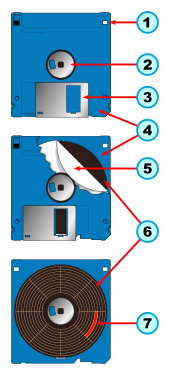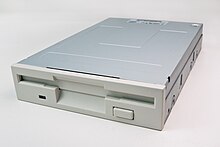How Old School Floppy Drives Worked CD | DVD| Blueray
A floppy disk, also called a floppy, diskette, or just disk, is a type of disk storage composed of a disk of thin and flexible magnetic storage medium, sealed in a rectangular plastic enclosure lined with fabric that removes dust particles. Floppy disks are read and written by a floppy disk drive (FDD).
Floppy disks, initially as 8-inch (200 mm) media and later in 5 1⁄4-inch (133 mm) and 3 1⁄2-inch (90 mm) sizes, were a ubiquitous form of data storage and exchange from the mid-1970s into the first years of the 21st century. By 2006 computers were rarely manufactured with installed floppy disk drives; 3 1⁄2-inch floppy disks can be used with an external USB floppy disk drive, but USB drives for 5 1⁄4-inch, 8-inch, and non-standard diskettes are rare to non-existent. These formats are usually handled by older equipment.
5 1⁄4-inch floppy disk
The head gap of an 80‑track high-density (1.2 MB in the MFM format) 5 1⁄4‑inch drive (a.k.a. Mini diskette, Mini disk, or Minifloppy) is smaller than that of a 40‑track double-density (360 KB) drive but can format, read and write 40‑track disks well provided the controller supports double stepping or has a switch to do such a process. 5 1⁄4-inch 80-track drives were also called hyper drives. A blank 40‑track disk formatted and written on an 80‑track drive can be taken to its native drive without problems, and a disk formatted on a 40‑track drive can be used on an 80‑track drive. Disks written on a 40‑track drive and then updated on an 80 track drive become unreadable on any 40‑track drives due to track width incompatibility.Single sided disks were coated on both sides, despite the availability of more expensive double sided disks. The reason usually given for the higher cost was that double sided disks were certified error-free on both sides of the media. Double-sided disks could be used in some drives for single-sided disks, as long as an index signal was not needed. This was done one side at a time, by turning them over (flippy disks); more expensive dual-head drives which could read both sides without turning over were later produced, and eventually became used universally.
3 1⁄2-inch floppy disk
Internal parts of a 3 1⁄2‑inch floppy disk.
1) A hole that indicates a high-capacity disk.
2) The hub that engages with the drive motor.
3) A shutter that protects the surface when removed from the drive.
4) The plastic housing.
5) A polyester sheet reducing friction against the disk media as it rotates within the housing.
6) The magnetic coated plastic disk.
7) A schematic representation of one sector of data on the disk; the tracks and sectors are not visible on actual disks.
8) The write protection tab (unlabeled) is upper left.
1) A hole that indicates a high-capacity disk.
2) The hub that engages with the drive motor.
3) A shutter that protects the surface when removed from the drive.
4) The plastic housing.
5) A polyester sheet reducing friction against the disk media as it rotates within the housing.
6) The magnetic coated plastic disk.
7) A schematic representation of one sector of data on the disk; the tracks and sectors are not visible on actual disks.
8) The write protection tab (unlabeled) is upper left.
A 3 1⁄2-inch floppy disk drive.
The first Macintosh computers use single-sided 3 1⁄2-inch floppy disks, but with 400 KB formatted capacity. These were followed in 1986 by double-sided 800 KB floppies. The higher capacity was achieved at the same recording density by varying the disk rotation speed with head position so that the linear speed of the disk was closer to constant. Later Macs could also read and write 1.44 MB HD disks in PC format with fixed rotation speed.
All 3 1⁄2-inch disks have a rectangular hole in one corner which, if obstructed, write-enabled the disk. A sliding detented piece can be moved to block or reveal the part of the rectangular hole that is sensed by the drive. The HD 1.44 MB disks have a second, unobstructed hole in the opposite corner which identifies them as being of that capacity.
In IBM-compatible PCs, the three densities of 3 1⁄2-inch floppy disks are backwards-compatible: higher density drives can read, write and format lower density media. It is also possible to format a disk at a lower density than it was intended for, but only if the disk is first thoroughly demagnetized with a bulk eraser, as the high density format is magnetically stronger and will prevent the disk from working in lower density modes.
Writing at different densities than disks were intended for, sometimes by altering or drilling holes, was possible but deprecated. The holes on the right side of a 3 1⁄2‑inch disk can be altered as to make some disk drives and operating systems treat the disk as one of higher or lower density, for bidirectional compatibility or economical reasons. Some computers, such as the PS/2 and Acorn Archimedes, ignored these holes altogether.
It is possible to make a 3 1⁄2-inch floppy disk drive be recognized by a system as a 5 1⁄4‑inch 360 KB or 1200 KB drive, and to read and write disks with the same number of tracks and sectors as those disks; this had some application in data exchange with obsolete CP/M systems.






Comments
Post a Comment